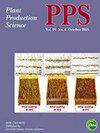优化施氮可通过改善分蘖质量提高水稻产量
IF 1.3
3区 农林科学
Q2 AGRONOMY
引用次数: 4
摘要
分蘖的数量和质量决定着水稻的产量。为探究氮肥优化施用如何通过影响分蘖生长来提高水稻产量,在前人研究的基础上,进行了3种氮肥处理对分蘖生长发育影响的盆栽试验。结果表明:OFA处理下,次生分蘖和高叶位分蘖出苗率下降,随初生分蘖数量增加而增加;无效分蘖的减少增加了每分蘖生物量和氮素的积累,促进了穗的发育。与传统氮肥处理相比,施氮处理的分化小花数增加10.85% ~ 21.70%,灌浆总小花数增加9.67% ~ 18.95%,增产9.6%。初生分蘖,尤其是第一、二、五、六叶分蘖,是水稻品质优良的分蘖,对水稻产量的贡献很大,受施氮量的影响显著。充分利用氮素对分蘖品质的调节作用,有利于少施氮稳产或不施氮增产。图形抽象本文章由计算机程序翻译,如有差异,请以英文原文为准。
Optimized nitrogen application increases rice yield by improving the quality of tillers
ABSTRACT The quantity and quality of tillers determine the yield of rice. In order to explore how optimized nitrogen fertilizer application (OFA) increases rice yield by affecting tiller growth, a pot experiment with three nitrogen treatments was performed on the basis of previous researches to investigate the growth and development of tillers. Results showed that under OFA, the emerging rate of secondary tillers and high leaf position tillers decreased, which increased with the number of primary tillers. The decrease of ineffective tillers increased the accumulation of biomass and nitrogen per tiller, which promoted the development of panicles. Compared with traditional nitrogen fertilizer application (TFA), the differentiated number of spikelets increased by 10.85%–21.70%, which led to the total number of filled spikelets increasing by 9.67%–18.95%, resulting in 9.6% increase in rice yield. Primary tillers, especially at the first, second, fifth, and sixth leaf positions, were the superior tillers in good quality, which made great contribution to rice yield and were significantly affected by nitrogen application. Making full use of the regulation effect of nitrogen on the quality of tillers will help to stabilize rice yield with less nitrogen input or increase rice yield without adding nitrogen input. Graphical abstract
求助全文
通过发布文献求助,成功后即可免费获取论文全文。
去求助
来源期刊

Plant Production Science
农林科学-农艺学
CiteScore
5.10
自引率
4.00%
发文量
27
审稿时长
>36 weeks
期刊介绍:
Plant Production Science publishes original research reports on field crops and resource plants, their production and related subjects, covering a wide range of sciences; physiology, biotechnology, morphology, ecology, cropping system, production technology and post harvest management. Studies on plant production with special attention to resource management and the environment are also welcome. Field surveys on cropping or farming system are also accepted. Articles with a background in other research areas such as soil science, meteorology, biometry, product process and plant protection will be accepted as long as they are significantly related to plant production.
 求助内容:
求助内容: 应助结果提醒方式:
应助结果提醒方式:


